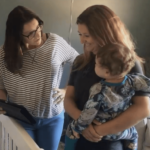When you buy through our links, we may earn a commission. Products or services may be offered by an affiliated entity. Learn more.
Sleep Training for Babies
Babies sleep a lot. For their first year of life, babies need approximately nine to 12 hours of sleep a day, in addition to regular naps. The only problem is that they tend to sleep in spurts , a combination of sleeping at night and napping during the day.
It takes babies around three to six months to develop their internal body clock, or circadian rhythm. At this point, they’ll naturally want to sleep more at night and be awake more during the day. For sleepy parents who want to encourage their little ones to spend more of their nighttime sleep consistently asleep, sleep training may be the key.
What Is Sleep Training?
Sleep training is the process of helping a baby learn to fall asleep independently and stay asleep through the night. It typically involves establishing a consistent bedtime routine and gradually teaching the baby to self-soothe without being rocked, fed, or held as they fall asleep.
There are several sleep training methods—ranging from gentle to more structured approaches—and the right one often depends on the baby’s age, temperament, and the family’s preferences. The goal of sleep training is to promote healthy sleep habits for both baby and parents.
With some sleep training methods, babies can sleep on their own within a matter of days. For others, particularly gentler methods that minimize crying, the process can take longer. There is no one right way to sleep train, but staying consistent — and patient — are key to success.
Help Your Baby Sleep Better With Pediatric Sleep Coaching

our partner at sleepdoctor.com
Learn More“Life-changing! My anxiety about my son’s sleeping habits were immediately reduced after talking to Sara. She went above and beyond to tailor a schedule to our goals, answer our questions, keep us on track, and check in to encourage us when we just thought we couldn’t do it anymore.”
Rachael B. – Verified Customer
When to Start Sleep Training
Babies aren’t ready for sleep training until they’re 4 to 6 months old. Before then, they haven’t developed the circadian rhythms that will help them sleep through the night . At this age, they’re able to pick up skills like sleeping independently, and they haven’t gotten too used to you rocking them to sleep.
Six months is generally agreed to be a good time to start sleep training, although you can begin as early as 4 months or as late as nine months. Nine months can be better for some babies, as most no longer need to eat during the night at this age.
It can be difficult to know when your baby is ready for sleep training. However, if your baby starts to fall asleep on their own at night (even if they wake up throughout the night), they’re most likely ready.
Sleep Training Methods
Parents use various methods of sleep training parents, and all of them can be effective . The best method for your family will depend on what you and your baby are most comfortable with.
Cry It Out Method
The Cry It Out sleep training method is also known as extinction, full extinction, or CIO for short. With this method, parents take their baby through a bedtime routine, cuddle with them and give them a kiss goodnight, and then leave the room. If the baby cries, the parent does not respond. Eventually, the baby tires themselves out from crying or self-soothes back to sleep.
This method is well-known, and proponents say that it works, and quickly. However, many parents feel uncomfortable letting their baby cry out and not comforting them. They worry it will elevate the baby’s stress levels , cause trauma, and lead the child to think they can’t rely on their parents to be there for them. It’s also very difficult for many parents to hear their baby cry and not be able to help them.
Ferber Method
The Ferber method is similar to Cry It Out, but more gradual, hence its nicknames of “graduated extinction,” progressive waiting, and the interval method.
With this method, parents follow the same routine of taking their baby through a bedtime ritual, cuddling them and kissing them goodnight, and then leaving the room and shutting the door. For the first few nights, the parents immediately return whenever the baby cries, patting them and ensuring they’re calm before leaving the room again. After the first few nights, parents gradually increase the amount of time they let the baby cry before reentering the room, eventually reaching a point where the baby self-soothes.
This method appeals to parents who are uncomfortable with the black-and-white nature of the CIO method, but some still feel it can be traumatizing for the baby. However, studies of the Ferber Method have found no evidence of long-term negative effects on a child’s emotions, stress, behavior, or attachment to their parent. If you choose this method, be aware that your baby will cry at some point, and you won’t be able to respond.
Check and Console Method
A variation of the Ferber method, the Check and Console method encourages parents to check on their baby and console them before they even start to cry.
For example, on the first few nights, parents may leave the room and enter a minute or two later to tell them they love them or to give them a soft pat. Parents keep leaving the room and checking back in, gradually increasing the intervals to about 15 minutes until they fall asleep.
This method can take longer — up to a week — and requires more involvement from the parents. Be attentive to how your baby responds to the Check and Console method. Checking in may excite them and make them more upset when you leave, in which case another method may be a better option.
Pick Up/Put Down Method
The Pick Up/Put Down method is a gentle sleep training approach that helps babies learn to fall asleep independently while still feeling comforted by their caregiver’s presence. When using this method, you place your baby in their crib while they’re drowsy but awake. If they cry or become upset, you gently pick them up to soothe them. Once they’re calm, you put them back down and repeat the process as needed.
This technique requires patience and consistency, but it can be a good fit for parents who want to avoid extended crying while still encouraging self-soothing skills. The Pick Up/Put Down method works best for babies between 4 and 8 months old, as they’re developmentally able to begin learning independent sleep habits but are still responsive to parental reassurance.
Fading Method
The Fading method, also known as “camping out,” encourages parents to stay in their child’s room until they fall asleep. Parents can do this by standing, or by sitting in a chair in their child’s room, a variation known as the Chair method.
With this method, parents take their child through a bedtime routine and put them in bed while the child is still drowsy. Then, the parents stay by their side until they fall asleep. Each night, the parent gradually moves further away from their child while still remaining in their sight. A major tenet of the Fading or Chair method is providing minimal comfort to the child, verbal or physical, while maintaining their physical distance.
It’s common for babies to cry during the Fading method, which can be difficult for parents to experience, particularly because they can see them crying (as opposed to only hearing them, as with the Cry It Out method). Fading also typically takes longer than the CIO or Ferber methods — up to two weeks — but gives some parents more peace of mind since they don’t feel like they’re abandoning their child.
“No Tears” Method
This method, also known as Gentle Sleep Training, focuses on helping your baby learn to sleep on their own without any crying. To accomplish this, the method leans heavily on a consistent bedtime routine. This routine should follow the same set of activities, done in the same order, so the baby comes to recognize these activities as a transition from day to night, and consequently bedtime.
Parents can use a variety of tactics. Some parents may use a variation of the Ferber method and leave the room entirely, but they will reenter any time the baby cries. Other parents use the Fading method as a basis, with a gradual increase in physical distance between themselves and their baby at night.
But, when the baby cries, they reassure them by shushing and patting them, instead of simply using verbal cues as with the Fading method. The trick is to lay them back down before they fall asleep, so they learn to feel confident and comfortable falling asleep on their own instead of in your arms.
Gentle Sleep Training methods are less emotionally stressful since they involve no crying, but they take longer to be successful. As a result, the parent may suffer more sleep deprivation with this sleep training method and a potential regression.
Pros and Cons of Sleep Training
Sleep training is effective and offers significant benefits to both babies and parents, with no evidence of negative long-term effects.
When infants can’t sleep well, it’s distressing to both the baby and the parents. Children may develop pediatric insomnia , and parents are at greater risk of depression, stress, and poor health. On the other hand, when babies get more sleep, parents feel better, and so do their babies. Babies who get more restful sleep have fewer developmental and behavioral issues , and have a happier temperament overall.
Both the Ferber and Fading methods have been found to significantly improve infant sleep, parental sleep, and parental mental health within three months, with sustained improvement two months later.
At a two-year follow-up, both approaches still indicated no long-term negative mental health impact on the babies, and the mothers were less likely to report symptoms of depression. At a five-year follow-up, when the children were six, there was still no evidence that sleep training had any sort of negative effect on the children.
While sleep training can be effective for many families, it’s not without its challenges. Some methods, especially those involving periods of crying, can be emotionally difficult for both parents and babies. There’s also no one-size-fits-all approach—what works for one child may not work for another, leading to frustration or setbacks.
Additionally, sleep training requires consistency and timing, which can be tough to maintain during travel, illness, or developmental changes like teething or growth spurts. For some families, the pressure to “get it right” can add stress rather than relief, making it important to choose an approach that aligns with your values, lifestyle, and your baby’s temperament.
Tips for Sleep Training
Whatever sleep training method you choose, these tips can help you stay calm and consistent throughout the process.
- Allow your baby to learn to self-soothe. By putting your baby down when they’re getting drowsy, they’ll get in the habit of falling asleep on their own. Then, when they wake up at night, they’re more equipped to put themselves back to sleep without your help because they’ve practiced.
- Separate yourself from your baby. Your baby doesn’t have to have their own bedroom to sleep train, but it’s important that you find a way to separate yourself from them so they can learn to self-soothe.
- Stick to a consistent bedtime. Consistency is essential in sleep training. You’re creating a whole new schedule for your child. Create consistency by picking a bedtime and sticking to it every night.
- The “right” way to sleep train is the right way for you and your baby. There are several different approaches to sleep training. Some are more suitable for some families, while some work better for others. There’s no one best way to sleep train; it’s about finding what works for your child.
- Know that there will be some rough nights. Sleep training can be a bumpy road. There may be times when one parent is out of town, or your baby is feeling under the weather. Take a deep breath, try to be patient, and accept it as part of the process.
- You will ultimately be successful. Most babies sleep through the night by 4 to 9 months old, so don’t get discouraged! Keep a sleep training diary to track your progress (and the bumpy spots along the way) so you can stay positive and consistent.
- Sleep training is a tool you can use as your child’s routine changes. As children grow and develop, start attending school, or experience other life changes, they may need adjustments to their sleep schedule. When that happens, you can sleep train them again.
Frequently Asked Questions
Do babies ever sleep through the night without sleep training?
Yes, some babies naturally learn to sleep through the night without formal sleep training. Every baby is different—factors like temperament, sleep environment, and developmental stage all play a role. While some babies settle into longer sleep stretches on their own, others may need more guidance to develop healthy sleep habits.
How do bedtime routines fit into sleep training?
Bedtime routines represent a key element in each of the sleep training methods above. They create a
sense of consistency
for babies, which reassures them and helps them feel safe to sleep. Babies also have no sense of day and night in their infancy, and bedtime routines can help them distinguish between the two.
By following the same set of activities each night, bedtime routines help your brain recognize that it’s time for bed, especially if the activities are calming and quiet. For children, bedtime routines may include activities like taking a bath, brushing their teeth, reading a bedtime story with you (or making one up together), singing a quiet song, saying goodnight to their favorite toys, and, of course, a kiss goodnight!
What is the 5-3-3 rule for baby sleep?
The 5-3-3 rule is a loose guideline for structuring a baby’s sleep schedule: 5 hours of wake time before the first nap, 3 hours of wake time before the second nap, and 3 hours before bedtime. While this rule isn’t universal, it can help caregivers think about spacing naps and bedtime in a way that aligns with a baby’s natural sleep rhythms—especially for older infants and toddlers who are down to one or two naps a day.
What is the hardest night of sleep training?
For most families, the first or second night of sleep training is the hardest. This is when babies are adjusting to new expectations and routines, which can lead to more crying or resistance. The good news is that many parents see noticeable improvements in just a few nights as their baby begins to self-soothe and adapt to the new sleep pattern.

Still have questions? Ask our community!
Join our Sleep Care Community — a trusted hub of sleep health professionals, product specialists, and people just like you. Whether you need expert sleep advice for your insomnia or you’re searching for the perfect mattress, we’ve got you covered. Get personalized guidance from the experts who know sleep best.
References
11 Sources
-
A.D.A.M. Medical Encyclopedia. (2020, October 2). Bedtime habits for infants and children. MedlinePlus.
https://medlineplus.gov/ency/article/002392.htm -
Pennestri, M. H., Laganière, C., Bouvette-Turcot, A. A., Pokhvisneva, I., Steiner, M., Meaney, M. J., Gaudreau, H., & Mavan Research Team (2018). Uninterrupted Infant Sleep, Development, and Maternal Mood. Pediatrics, 142(6), e20174330
https://pubmed.ncbi.nlm.nih.gov/30420470/ -
Korownyk, C., & Lindblad, A. J. (2018). Infant sleep training: Rest easy?. Canadian Family Physician/Medecin de Famille Canadien, 64(1), 41.
https://pubmed.ncbi.nlm.nih.gov/29358251/ -
Mindell, J. A., Kuhn, B., Lewin, D. S., Meltzer, L. J., Sadeh, A., & American Academy of Sleep Medicine (2006). Behavioral treatment of bedtime problems and night wakings in infants and young children. Sleep, 29(10), 1263–1276.
https://pubmed.ncbi.nlm.nih.gov/17068979/ -
Gradisar, M., Jackson, K., Spurrier, N. J., Gibson, J., Whitham, J., Williams, A. S., Dolby, R., & Kennaway, D. J. (2016). Behavioral Interventions for Infant Sleep Problems: A Randomized Controlled Trial. Pediatrics, 137(6), e20151486
https://publications.aap.org/pediatrics/article/137/6/e20151486/52401/Behavioral-Interventions-for-Infant-Sleep-Problems -
Goetting, M. G., & Reijonen, J. (2007). Pediatric insomnia: a behavioral approach. Primary care, 34(2), 427–x.
https://linkinghub.elsevier.com/retrieve/pii/S0095454307000218 -
Spruyt, K., Aitken, R. J., So, K., Charlton, M., Adamson, T. M., & Horne, R. S. (2008). Relationship between sleep/wake patterns, temperament and overall development in term infants over the first year of life. Early human development, 84(5), 289–296.
https://linkinghub.elsevier.com/retrieve/pii/S0378378207001144 -
Hiscock, H., Bayer, J., Gold, L., Hampton, A., Ukoumunne, O. C., & Wake, M. (2007). Improving infant sleep and maternal mental health: a cluster randomised trial. Archives of disease in childhood, 92(11), 952–958.
https://pubmed.ncbi.nlm.nih.gov/17158146/ -
Hiscock, H., Bayer, J. K., Hampton, A., Ukoumunne, O. C., & Wake, M. (2008). Long-term mother and child mental health effects of a population-based infant sleep intervention: cluster-randomized, controlled trial. Pediatrics, 122(3), e621–e627.
https://publications.aap.org/pediatrics/article/122/3/e621/72287/Long-term-Mother-and-Child-Mental-Health-Effects -
Price, A. M., Wake, M., Ukoumunne, O. C., & Hiscock, H. (2012). Five-year follow-up of harms and benefits of behavioral infant sleep intervention: randomized trial. Pediatrics, 130(4), 643–651.
https://publications.aap.org/pediatrics/article/130/4/643/30241/Five-Year-Follow-up-of-Harms-and-Benefits-of -
Mindell, J. A., & Williamson, A. A. (2018). Benefits of a bedtime routine in young children: Sleep, development, and beyond. Sleep Medicine Reviews, 40, 93–108.
https://pubmed.ncbi.nlm.nih.gov/29195725/





























